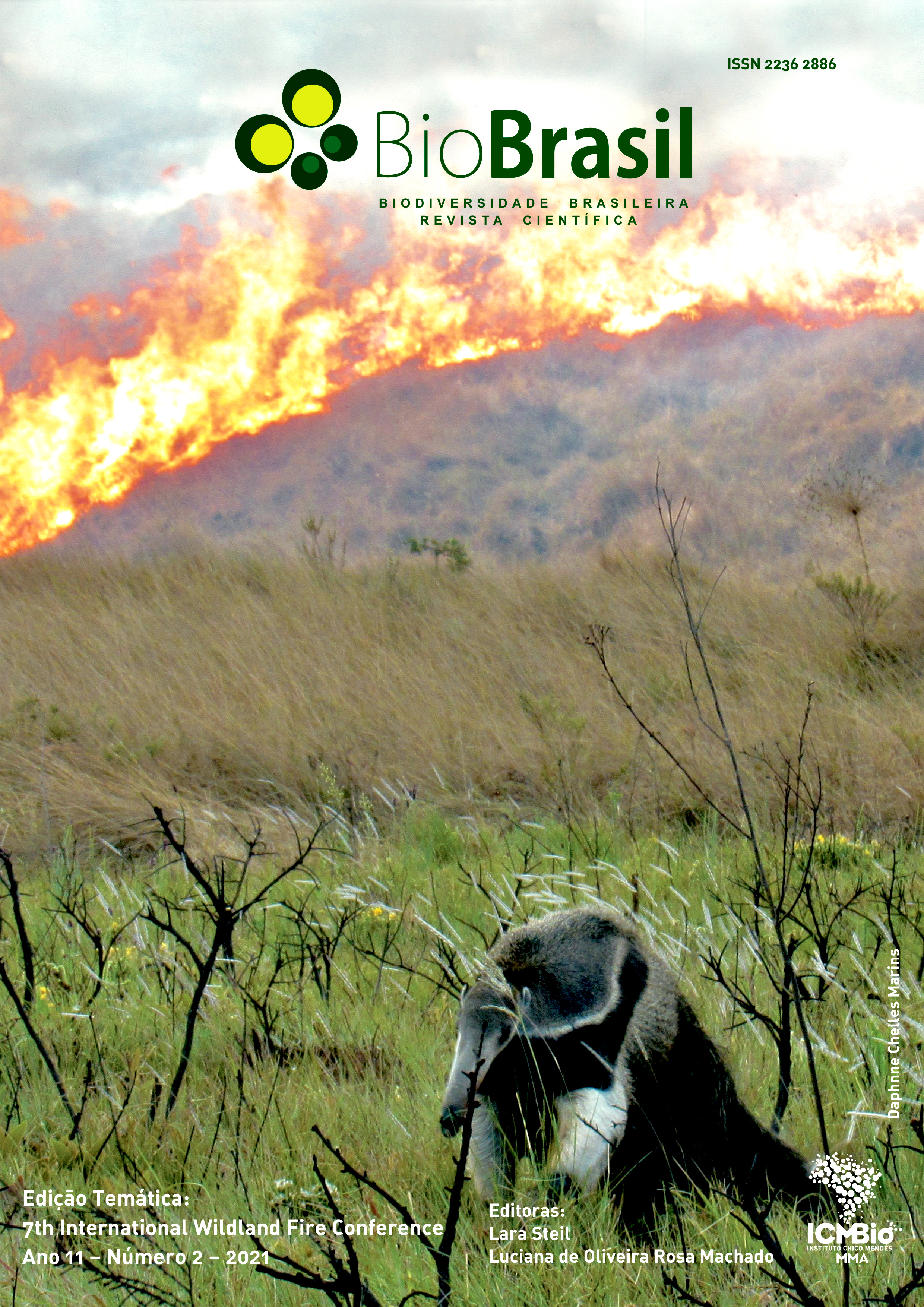Oportunidades de mercado para apoiar o manejo sustentável do fogo em paisagens com remanescentes de cerrado (savana) Pirofíticos
DOI:
https://doi.org/10.37002/biodiversidadebrasileira.v11i2.1725Palavras-chave:
Regimes de fogo, incêndios, queima prescrita, manejo do fogo indígenaResumo
O manejo do fogo sustentável da vegetação remanescente do Cerrado (savana) enfrenta muitos desafios no Brasil e regionalmente, incluindo: o legado de políticas coloniais impostas de supressão do fogo; fragmentação massiva do bioma Cerrado por meio do desenvolvimento agropastoril; perda de conhecimento e da experiência cultural de manejo do fogo; ocorrência de incêndios severos no final da estação seca devido à falta de manejo apropriado com queima prescrita no geral. Como contexto para enfrentar esses desafios, primeiro fornecemos exemplos ilustrativos de um programa bem-sucedido, com base no mercado, implementado nas savanas do norte da Austrália, pirofíticas, e o recente estabelecimento de um programa piloto complementar em savanas suscetíveis a incêndios em Botswana. Em seguida, delineamos a necessidade e oportunidade de desenvolver uma abordagem análoga de manejo do fogo no Cerrado brasileiro, observando que: (a) há um potencial considerável para a implementação de manejo do fogo com apoio e incentivo em áreas frequentemente queimadas por incêndios, especialmente em territórios indígenas; (b) conforme demonstrado pela experiência australiana, esse desenvolvimento pode ser alcançado rapidamente em condições políticas favoráveis. Talvez a chave para essa transformação rápida seja reconhecer que todos se beneficiam - climas globais, sustentabilidade ecológica regional e população local, tanto cultural quanto financeiramente. O artigo fornece um resumo contextual de apresentações e discussões em Oficina Técnica associadas à Sessão Especial da 7ª Conferência Internacional sobre Incêndios Florestais, em Campo Grande, Brasil, focada de modo geral no tema descrito no título deste artigo
Downloads
Referências
Ansell J et al. Contemporary Aboriginal savanna burning projects in Arnhem Land: a regional description and analysis of the fire management aspirations of Traditional Owners. International Journal of Wildland Fire, 29: 371-385, 2020.
Bowman DMJS & Panton WJ. Decline of Callitris intratropica in the Northern Territory: implications for pre- and post-colonisation fire regimes. Journal of Biogeography, 20: 373-381, 1993.
CoA (Commonwealth of Australia). Carbon Credits (Carbon Farming Initiative) Reduction of Greenhouse Gas Emissions through Early Dry Season Savanna Burning. Methodology Determination 2013. Australian Government. <http://www.comlaw.gov.au/Series/F2013L01165>. 2013.
CoA (Commonwealth of Australia). Carbon Credits (Carbon Farming Initiative - Emissions Abatement through Savanna Fire Management) Methodology Determination 2015. Canberra: ComLaw, Australian Government. <http://www.comlaw.gov.au/Details/F2015L00344>. 2015.
CoA (Commonwealth of Australia). Carbon Credits (Carbon Farming Initiative - Savanna Fire Management - Emissions Avoidance) Methodology Determination 2018. Department of Environment and Energy, Australian Government. < https://www.legislation.gov. au/Details/F2018L00560>.
Cook GD, Meyer CP, Muepu M & Liedloff AC. Dead organic matter and the dynamics of carbon and greenhouse gas emissions in frequently burnt savannas. International Journal of Wildland Fire, 25: 1252-1263, 2016.
DoEE (Department of Environment and Energy). Savanna fire management carbon farming framework. Commonwealth of Australia. . 2019.
Durigan G. Zero-fire: not possible nor desirable in the Cerrado of Brazil. Flora, 268: 151612, 2019.
Durigan G & Ratter JA. The need for a consistent fire policy for Cerrado conservation. Journal of Applied Ecology, 53: 11-15, 2016.
Schmidt IB et al. Fire management in the Brazilian Savanna: first steps and the way forward. Journal of Applied Ecology, 55: 2094-2101. 2018.
Silva LCR, Hoffmann WA, Rossatto DR, Haridasan M, Franco AC & Horwath WR. Can savannas become forests? A coupled analysis of nutrient stocks and fire thresholds in central Brazil. Plant and Soil, 373(1-2): 829-842, 2013.
Townsend SA & Douglas MM. The effect of a wildfire on stream water quality and catchment water yield in a tropical savanna excluded from fire for 10 years (Kakadu National Park, North Australia). Water Research, 38: 3051-3058, 2004.
UNU (United Nations University). The global potential of Indigenous Fire Management. Institute of Advanced Studies, United Nations University, Tokyo. <http://i.unu.edu/media/tfm.unu.edu/news/2151/Final-ReportFindings-Regional-Feasibility-Assessments-ISFMI.pdf>.2015.
van der Werf et al. Global fire emissions estimates during 1997-2016. Earth System Science Data, 9: 697-720, 2017.
Whitehead PJ, Russell-Smith J & Yates CP. Carbon markets and improved management of fire in north Australian savannas: identifying sites for productive targeting of emissions reductions. The Rangelands Journal, 36: 371-388, 2014.
Woinarski JCZ, Williams RJ, Price O & Rankmore B. Landscapes without boundaries: wildlife and their environments in northern Australia. Wildlife Research, 32: 377-388, 2005.
Ziembicki MR et al. Stemming the tide: progress towards resolving the causes of decline and implementing management responses for the disappearing mammal fauna of northern Australia. Therya, 6: 169-225, 2015.
Downloads
Publicado
Edição
Seção
Licença
Copyright (c) 2021 Biodiversidade Brasileira - BioBrasil

Este trabalho está licenciado sob uma licença Creative Commons Attribution-NonCommercial-NoDerivatives 4.0 International License.
Os artigos estão licenciados sob uma licença Creative Commons Atribuição-NãoComercial-SemDerivações 4.0 Internacional (CC BY-NC-ND 4.0). O acesso é livre e gratuito para download e leitura, ou seja, é permitido copiar e redistribuir o material em qualquer mídia ou formato.











